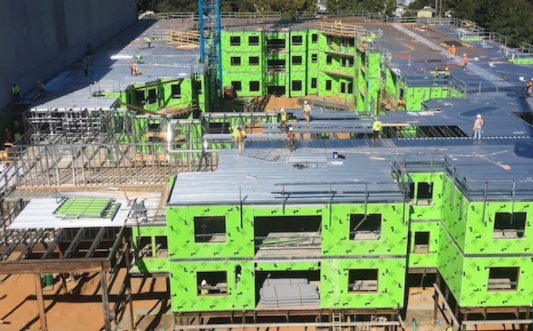Builder Chooses Cold-Formed Steel to Meet University of Virginia Student Housing Project Goals

The Augustine Group LLC specializes in providing consulting services to owners and bringing in the right teams under a single source contract for new construction projects. They have been very successful in solving their clients’ challenges in determining the best structural system to use to meet budget and timing demands. Augustine recently faced a tight deadline for a student housing project in Charlottesville, Virginia, where they needed to ensure University of Virginia students were able to move into an off-campus building prior to the start of the new school year.
“Move-in typically begins in July, so the planned timeline for constructing The Standard apartment complex in Charlottesville was sped up. The project is estimated to be completed by July 1 to ensure students will be able to move in prior to the start of the 2018 fall semester,” said Rakesh Patel, principal member, Augustine Group LLC. “While speed is the name of the game, quality can’t be compromised, so our choice in materials was an important decision. The client looked at several wood options, but ultimately decided on cold-formed steel because it was the best choice to meet our quality needs and deadline.”
By choosing cold-formed steel (CFS) for the project, Augustine tapped into both the versatility and durability that are unique qualities of the product, which enabled them to maximize its use for 34,000 linear feet of non-load bearing (nonstructural) CFS walls and 38,000 linear feet of prefabricated load-bearing (structural) CFS walls, which were panelized off-site.
“Using CFS for both load-bearing and non-load-bearing applications provides more flexibility in the building weight and height,” said Patel. “Because CFS is lighter and offers a tremendous strength-to-weight ratio, we were able to build strong but light structures to support the weight of the 363,000 square-foot building. It also allowed us to build higher than five stories, which is the threshold for wood-framed buildings. With steel, we were able to achieve seven stories, resulting in additional occupancy potential and increased ROI on the project.”
Early occupancy potential, as a result of the decreased construction time afforded by steel, is also a consideration.
“An apartment complex with 60 units renting at $1,000 per month has the potential for $60,000 per month of early ROI,” said Patel. Another advantage of using steel is fewer load-bearing walls, which provides us with more interior design flexibility, like the ability to more easily change room sizes. You can’t achieve the same thing with wood framing.”

Using panelized CFS also provided consistent quality while reducing labor hours in the field. Components were created off-site and delivered to the job site.
“Using CFS helped us speed up our planned construction timeline,” said Patel. “Because the CFS assemblies were panelized, we reduced costs associated with labor hours in the field. Wall panels are a good example — we are able to frame each level of the structure in much shorter time, versus conventional framing.”
For anyone who is specifying materials for their project, Patel recommends seeing the bigger picture.
“Even in situations when steel itself costs more than other material choices, other savings make up for it. Savings that come with labor hours, preparation for follow-on trades, fire rating differences, insurance cost differences, occupancy ROI, property management costs and other considerations give CFS an edge.”
If you have questions about CFS or need support for a new or existing project, contact BuildSteel for free project assistance. We also offer a series of in-depth eBooks covering topics including design, safety, BIM, and more.